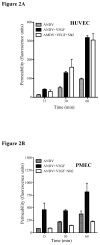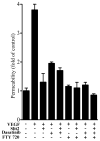Slit2-Robo4 receptor responses inhibit ANDV directed permeability of human lung microvascular endothelial cells
- PMID: 23702092
- PMCID: PMC3723770
- DOI: 10.1016/j.antiviral.2013.05.004
Slit2-Robo4 receptor responses inhibit ANDV directed permeability of human lung microvascular endothelial cells
Abstract
Hantaviruses nonlytically infect human endothelial cells (ECs) and cause edematous and hemorrhagic diseases. Andes virus (ANDV) causes hantavirus pulmonary syndrome (HPS), and Hantaan virus (HTNV) causes hemorrhagic fever with renal syndrome (HFRS). Hantaviruses enhance vascular endothelial growth factor directed EC permeability resulting in the disassembly of inter-endothelial cell adherens junctions (AJs). Recent studies demonstrate that Slit2 binding to Robo1/Robo4 receptors on ECs has opposing effects on AJ disassembly and vascular fluid barrier functions. Here we demonstrate that Slit2 inhibits ANDV and HTNV induced permeability and AJ disassembly of pulmonary microvascular ECs (PMECs) by interactions with Robo4. In contrast, Slit2 had no effect on the permeability of ANDV infected human umbilical vein ECs (HUVECs). Analysis of Robo1/Robo4 expression determined that PMECs express Robo4, but not Robo1, while HUVECs expressed both Robo4 and Robo1 receptors. SiRNA knockdown of Robo4 in PMECs prevented Slit2 inhibition of ANDV induced permeability demonstrating that Robo4 receptors determine PMEC responsiveness to Slit2. Collectively, this data demonstrates a selective role for Slit2/Robo4 responses within PMECs that inhibits ANDV induced permeability and AJ disassembly. These findings suggest Slit2s utility as a potential HPS therapeutic that stabilizes the pulmonary endothelium and antagonizes ANDV induced pulmonary edema.
Keywords: Hantavirus; Human endothelial cells; Inhibition; Permeability; Slit2.
Copyright © 2013 Elsevier B.V. All rights reserved.
Figures




Similar articles
-
Binding of the Andes Virus Nucleocapsid Protein to RhoGDI Induces the Release and Activation of the Permeability Factor RhoA.J Virol. 2021 Aug 10;95(17):e0039621. doi: 10.1128/JVI.00396-21. Epub 2021 Aug 10. J Virol. 2021. PMID: 34133221 Free PMC article.
-
Andes virus regulation of cellular microRNAs contributes to hantavirus-induced endothelial cell permeability.J Virol. 2010 Nov;84(22):11929-36. doi: 10.1128/JVI.01658-10. Epub 2010 Sep 15. J Virol. 2010. PMID: 20844033 Free PMC article.
-
VEGFR2 and Src kinase inhibitors suppress Andes virus-induced endothelial cell permeability.J Virol. 2011 Mar;85(5):2296-303. doi: 10.1128/JVI.02319-10. Epub 2010 Dec 22. J Virol. 2011. PMID: 21177802 Free PMC article.
-
Hantavirus pulmonary syndrome.Virus Res. 2011 Dec;162(1-2):138-47. doi: 10.1016/j.virusres.2011.09.017. Epub 2011 Sep 17. Virus Res. 2011. PMID: 21945215 Review.
-
Hantavirus regulation of endothelial cell functions.Thromb Haemost. 2009 Dec;102(6):1030-41. doi: 10.1160/TH09-09-0640. Thromb Haemost. 2009. PMID: 19967132 Review.
Cited by
-
Raised plasma Robo4 and cardiac surgery-associated acute kidney injury.PLoS One. 2014 Oct 31;9(10):e111459. doi: 10.1371/journal.pone.0111459. eCollection 2014. PLoS One. 2014. PMID: 25360813 Free PMC article.
-
Virus interactions with endothelial cell receptors: implications for viral pathogenesis.Curr Opin Virol. 2014 Aug;7:134-40. doi: 10.1016/j.coviro.2014.06.006. Epub 2014 Jul 24. Curr Opin Virol. 2014. PMID: 25063986 Free PMC article. Review.
-
Regulatory mechanisms of Robo4 and their effects on angiogenesis.Biosci Rep. 2019 Jul 10;39(7):BSR20190513. doi: 10.1042/BSR20190513. Print 2019 Jul 31. Biosci Rep. 2019. PMID: 31160487 Free PMC article. Review.
-
Cocaine enhances HIV-1 gp120-induced lymphatic endothelial dysfunction in the lung.Physiol Rep. 2015 Aug;3(8):e12482. doi: 10.14814/phy2.12482. Physiol Rep. 2015. PMID: 26311830 Free PMC article.
-
Slit2-Robo4 signal pathway and tight junction in intestine mediate LPS-induced inflammation in mice.Eur J Med Res. 2024 Jun 27;29(1):349. doi: 10.1186/s40001-024-01894-5. Eur J Med Res. 2024. PMID: 38937814 Free PMC article.
References
-
- Acevedo LM, Weis SM, Cheresh DA. Robo4 counteracts VEGF signaling. Nat Med. 2008;14:372–373. - PubMed
-
- Berger MM, Hesse C, Dehnert C, Siedler H, Kleinbongard P, Bardenheuer HJ, Kelm M, Bartsch P, Haefeli WE. Hypoxia impairs systemic endothelial function in individuals prone to high-altitude pulmonary edema. Am J Respir Crit Care Med. 2005;172:763–767. - PubMed
-
- Bustamante EA, Levy H, Simpson SQ. Pleural fluid characteristics in hantavirus pulmonary syndrome. Chest. 1997;112:1133–1136. - PubMed
-
- Chang B, Crowley M, Campen M, Koster F. Hantavirus cardiopulmonary syndrome. Semin Respir Crit Care Med. 2007;28:193–200. - PubMed
-
- Dehler M, Zessin E, Bartsch P, Mairbaurl H. Hypoxia causes permeability oedema in the constant-pressure perfused rat lung. Eur Respir J. 2006;27:600–606. - PubMed
Publication types
MeSH terms
Substances
Grants and funding
LinkOut - more resources
Full Text Sources
Other Literature Sources

